#LABYRINTH
Explore tagged Tumblr posts
Text

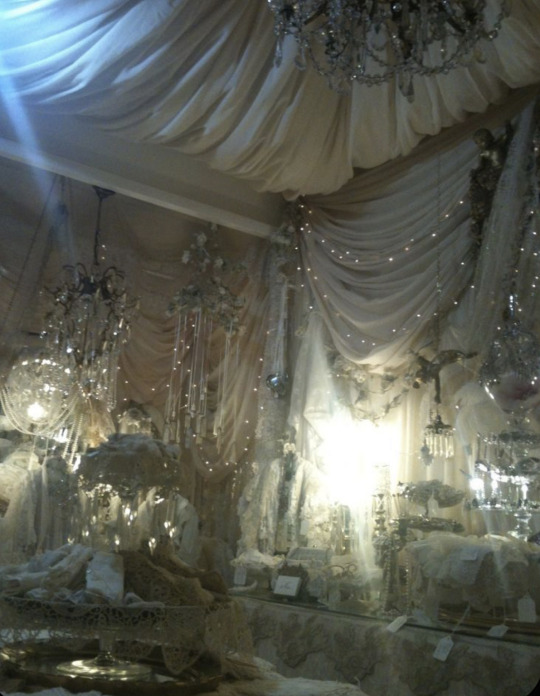
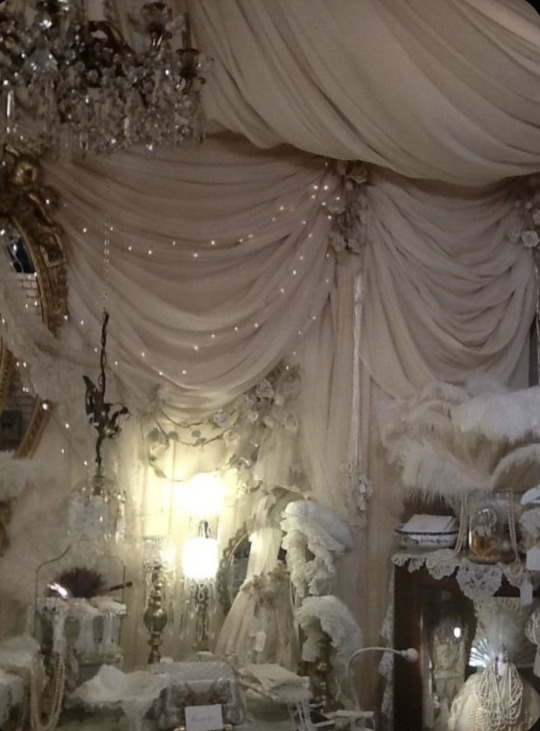

Labyrinth core 🪞✨
#labyrinth#fairycore#fairy aesthetic#faerie#whimsigothic#faecore#whimsigoth#cottage#fairy#goth#whimsigothix
8K notes
·
View notes
Text







Falling Star
#Lovecraft#Cosmicism#Mark Z Danielewski#SCP 2747#The King in Yellow#Labyrinth#Cosmic Horror#Metafiction#Dark Fantasy#Giftedness#Maze#Gothic#Mise En Abyme#The Navidson Record#꧁ঔৣ ྀི﴿ ྀི𓊇ྀི༻ ྀི﷽ ྀི𓆸 ྀི𑣿ྀིྀ🀥 ྀི𖦹꩜𖡎¿⸮𝓒𝓘𝓡𝓒⅏𐆒𝓛⅏؏ 𝓡꩜𝓤⅏ℵ𝓓 𝓐 ⅏🝉𝓣꩜⅏ℵ⅏؏𖭅ʖ༘̇𖡎꩜𖦹🀥 ྀི𑣿ྀིྀ𓆸 ྀི#꧁ঔৣ ྀི﴿ ྀི𓊇ྀི༻ ྀི﷽ ྀི𓆸 ྀི𑣿ྀིྀ🀥 ྀི𖦹꩜𖡎¿⸮𝓣𝓗⅏؏ ⅏𐆒𝓛𝓘𝓑𝓡𝓐𝓡𝓨 ꩜𝓕 𝓐𖭅𝓡𖭅 ⅏𐆒𝓛𝓐𝓑𝓐⅏؏𝓡⅏؏𖭅ʖ༘̇𖡎꩜𖦹🀥 ྀ#Weird Fiction#Circle Round A Stone#Keyhole Book Covers#If on a winter's night a traveller#H.P. Lovecraft#Lovecraftian#Lovecraftian Horror#Recursion#House of Leaves#House of Leaves SCP#Postmodern#Postmodernism#Godel Escher Bach#HoL
10K notes
·
View notes
Text






"A MASKED BALL OF THE MOST UNUSUAL MAGNIFICENCE" - Edgar Allen Poe
The Masque Of The Red Death (1964) | dir. Roger Corman Labyrinth (1986) | dir. Jim Henson The Addams Family (1991) | dir. Barry Sonnenfeld Phantom of the Opera (2004) | dir. Joel Schumacher Van Helsing (2004) | dir. Stephen Sommers Sweeney Todd: The Demon Barber of Fleet Stree (2007) | dir. Tim Burton
#the masque of the red death#labyrinth#the addams family#addams family#phantom of the opera#phantom of the opera (2004)#van helsing 2004#sweeney todd#sweeney todd the demon barber of fleet street#film#filmedit#film gifs#finalgirlbarbie
569 notes
·
View notes
Text





LABYRINTH (1986) dir. Jim Henson
#labyrinth#labyrinthedit#filmedit#filmtv#filmgifs#junkfooddaily#userstream#dailyflicks#80sedit#david bowie#*#by sonny
4K notes
·
View notes
Text










Mavigne, Or: A Treatise On The Metaphysics Of Inner Space Travel, And The Kingdom Of Erikaar, Whose Name Is Darkness Made Light, And Further Theological Expositions Thereof

🌹🥀The Library Of A.R. LaBaere🥀🌹 🌹🥀A.R. LaBaere🥀🌹 🌹🥀Cosmicism, Weird Fiction, Dark Fantasy, The Gothic, Poesy, And Intellectualism🥀🌹 All content is completely free of charge. Subscriptions are optional donation elements. 🌹🥀The Library Of A.R. LaBaere🥀🌹 Amazon.com: A.R. LaBaere: books, biography, latest update 🌹🥀The Library Of A.R. LaBaere🥀🌹 Amazon.com: A.R. LaBaere: Books, Biography, Blog, Audiobooks, Kindle A.R. LaBaere?'s answer to What is it like to have a 250 IQ? [email protected]

Max Ernst's "One Week of Kindness"
Which could also be called "A Week of Benevolence" - the original French being "Une semaine de bonté".
This post is a follow-up to a reblog I made, right here. Please go read this reblog first, because this post continues from all the info I placed there. If you don't go check it out first, you'll be slightly or massively confused.
I wanted to expand a bit on this fascinating piece of art, and to do so I'll use the info the Musée d'Orsay shared and put on their website when they organized an exposition of Une semaine de bonté.
An expo that deserves its own mention due to how exceptional it was. It was a 2008-2009 exposition of the original collages of Max Ernst the booklets were reproductions of. It was a grand world-tour that started in the Albertina palace of Vienna and ended in the Musée d'Orsay of Paris, passing by Brühl, Hamburg and Madrid. Why was it such a big deal? Because this was the second exposition of Ernst' work - the only other exposition of Une semaine de bonté's collages was in 1936, in the Museo de Arte Moderno of Madrid, just before the Spanish Civil War. It had been organized by Paul Eluard, who loved Ernst' work, but five of the illustrations couldn't be part of the exposition - due to being deemed too "indecent" or "blasphemous". And since this date, the works had never seen the light of day anymore, being preserved in private collections... It explains why the second exposition was such a big deal.
A few more sources for this collage-work I forgot to talk about: Beyond the general category of covers and illustrations of investigation stories/crime novels/polar tales, we also know that Ernst used illustrations of Sade's novels, the caricatures of Grandville, and the illustrations of Fantomas.

As with typical surrealist work, Une semaine de bonté offers a work of onirism that transcends the limits and categorizations imposed by society, by science, by our very conception of reality, and rather offers nonsensical visions and extraordinary wonders. It was the third "roman-collage" of Ernst, after "La femme 100 têtes" of 1929 and "Rêve d'une petite fille qui voulut entrer au Carmel" (1930). Throughout the illustrations, we find many references to the Bible, to famed legends, to fairy tales, to Greco-Roman mythology, but mixed with Ernst' recurring and favorite themes. More precisely, his strong rejections and dislikes: his rejection of the Church, his hatred of the bourgeoisie, his dislike of the traditional family, his refusal of patriotism...
Because Une semaine de bonté is actually a denunciation work, a great critique, a satirical caricature of the French society of the 1930s. Ernst superposes, subverts and reverses all sorts of stereotypical and cliches depictions, of either the "good society", or of the evil, the crime, the monster. Now, of course, there is no actual "real" or "good" story for this work. It is open to interpretation and everybody has to and must find their own meaning in it - as with all proper surrealist work... But there is still strong themes that form recurring motifs, and a message Ernst wasn't so subtle about.
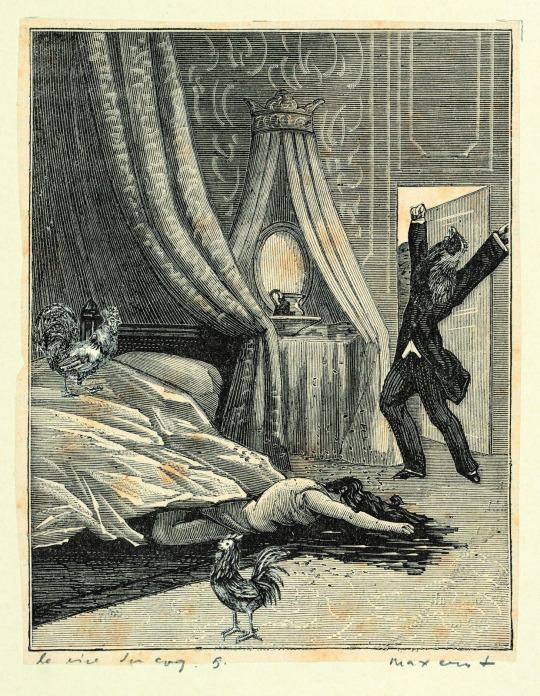
The satirical, ironical, cynical, biting nature of the work can be read in the very title, which plays on two levels. One, on a Christian level: "Seven capital elements" is, as I said, a parody of the "seven deadly sins/seven capital sins" ; the motif of a work centered around a week alerts that there will be numerous references to the Biblical genesis, but most importantly "One week of kindness" is a reference to "La semaine de bonté", The Week of Kindness, a 1927 association creating for social help. Tied to this subversion of typical Christan morals, ideas and values, is the second level of irony in the title: this collage-novel is called "One week of kindness"... And yet it depicts all sorts of violences and abuses. Its pages are filled with murders, tortures and natural disasters - and Ernst doesn't hesitate to subtly denounce the sensationalism of a society obsessed with depictions and illustrations of the most horrible and criminal sides of humanity.
It also is no wonder that this work was created during the 1930s. The ghosts of the World Wars are haunting this piece. On one side, Ernst was seeing with an anxious and angry eye the rise of violent nationalist movements and of brutal, discriminatory dictatorships - the very ones that would cause World War II. On the other side, Ernst was of this generation that inherited the trauma and memories of World War I, had to live with the broken and disfigured survivors of the "Great War". Ernst himself had served in the German army during the Great War (if you don't know, while Ernst was born and raised in Germany, he ended up having a triple-nationality, German, American and French). One can almost read in this book Ernst' vitriolic take on a society that distracts itself with materialism, excessive pleasures and sensationalism, in an attempt to bury the wraiths of its past, and to stay blind to the dangers ahead...
It is only by the last day of the week that the atrocities fade away, and that we return to pure oniric poetry, in a set of illustrations focusing on voluptuousness and fantasy, inviting to or glorifying freedom and dreams... Now let's take a look at the structure of the Week in more details.
Day 1: Sunday. Element: Mud. Example: The Lion of Belfort

(The Lion of Belfort is a commemorative statue of the Alsacian town of Belfort in France, in homage to how the city had been assieged by the Prussians during the Franco-Prussian war of 1870)
Another Christian subversion: the week doesn't begin here on a Monday, but on a Sunday. We also see some of the games Ernst has with the Biblical Genesis not just by waking the "last" day of Genesis the first day of the week, but also by associating to Sunday (the day of rest for a God that created everything already) the day of the "mud" (understand, the primordial mud from before the world was created, the "chaos", the "primordial soup" from which the universe had to be sculpted). Not only that, but Sunday, the holiest day of the week for Christians, is filled with brutal deaths, sadistic violence and blasphemous imagery.
More precisely, this booklet/day explores the relationships between men and women, male and females. And... let's just say Ernst has a bad view of it, since all the interactions between male and female characters in this booklet can be summarized by: persecution, seduction, theft, punishment, torture, death. Since the Lion of Belfort is the recurring theme, there is a recurring character throughout the illustrations of a lion-faced man. He is always in a position of power and domination, and it is no surprise: we often see him wear military decorations, political medals or even religious symbols such as the Sacred Heart. As a result, the lion-man clearly embodies all the dominating, oppressive and violent male-dominated organizations of the time: the political world, the military and the Church.
(If you are curious, the Musée d'Orsay offered the original picture on which the one above was based. It was taken from the Mémoire de Monsieur Claude:
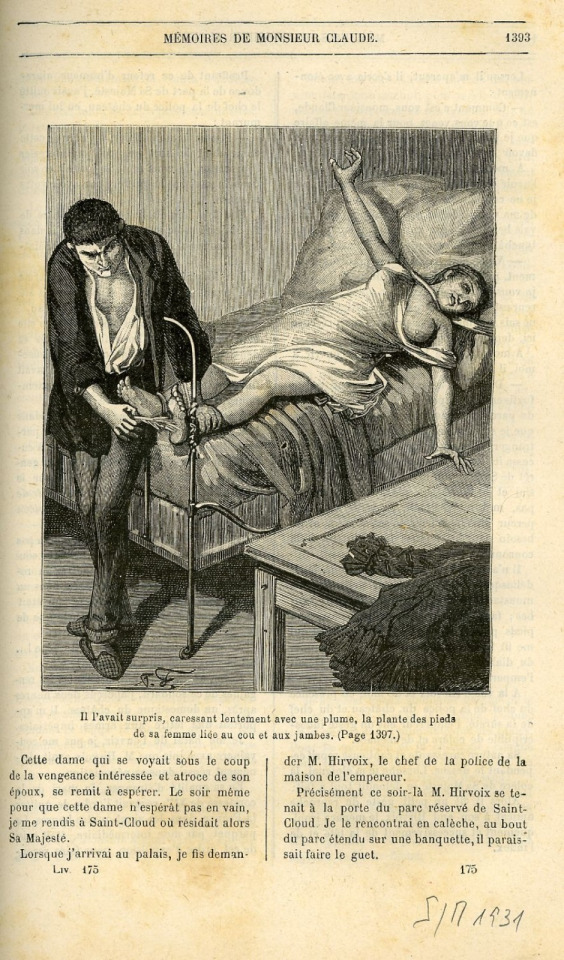
Day two: Monday. Element: Water. Example: Water.
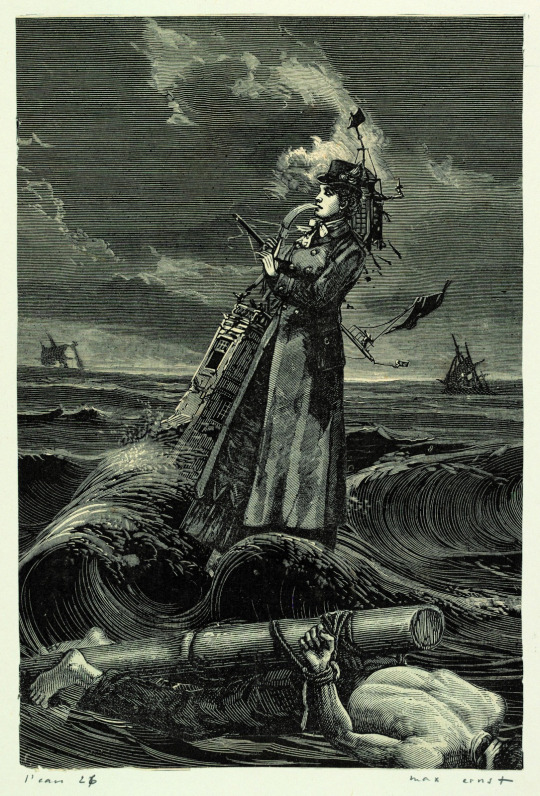
Unlike the male-dominated first booklet, this one is filled with female figures, making it the most "feminine" of all the days. There is still a lot of violence in it - but it is not a man-made violence anymore. Rather Ernst presents the violence of nature, the brutality of natural disasters - through water, a water that is seen flooding bedrooms, destroying bridges, or drowning entire streets of Paris.
Day three: Tuesday. Element: Fire. Example: The dragon's courtyard/The court of the dragon.

La Cour du Dragon, The Dragon's Courtyard is actually - or rather was - a famous street of Paris. It doesn't exist anymore, but it was in the 6th arrondissement, between today's Rue du Dragon and Rue de Rennes. This street was called as such because of a famous dragon-sculpture located at the top of one of its entrances - the dragon can still be seen at the Louvres I believe. And it is within illustrations of this "Dragon's courtyard" that the booklet begins.
The dragon is one of the recurring symbols of the booklet, with variations: dragons and snakes of all shapes and size that follow the characters around ; humans with various dragon or snake-like features ; or simply the presence of bat wings reminding of demons, sometimes counterbalanced by angelic characters with bird wings. Here, the caricature, in terms of setting and characters, clearly is of the bourgeoisie. Not only is Ernst making the world of the bourgeoisie "Hellish" by filling it with snakes, dragons, demons and flames, but he also seems to use the symbolism of the fire as a way to denote the cliche of the "passion bourgeoisie", the violence of passions, emotions and desires within the bourgeois world, leading to tragedies. (Opposing the "natural forces" of the water, here fire seems to be the human forces) It is no wonder that this booklet has a great emphasis on walls and doors, often decorated by surrealist symbols: they are here to evoke a cloistered, walled-up, compartimented world where walls and doors hide and try to restrain things such as fears, desires or dreams...
Day four: Wednesday. Element: Blood. Example: Oedipus.
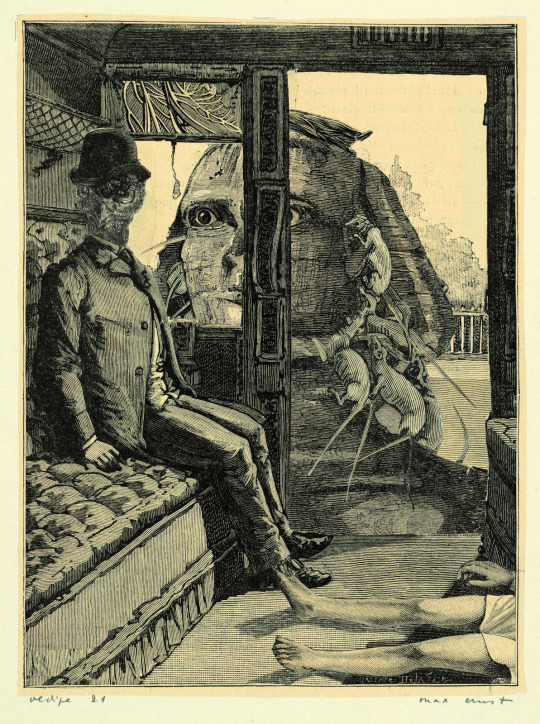
This booklet is entirely driven by the myth of Oedipus (that we know to have been one of the surrealists' favorite Greek myth). All the illustrations have one element or another of the legend, and keep retelling specific episodes of Oedipus' adventures. Oedipus killing his own father, the riddle of the Sphinx, or baby-Oedipus being abandoned at birth... Oedipus himself is symbolized in the collages as a bird-headed man.
One of the most famous collages of this booklet is the one that retranscribes the part of the legend that gave Oedipus his name, "swollen feet" or "swollen ankles", due to receiving a wound there as a baby. In Ernst's work, the bird-headed man (Oedipus) rather stabs in the foot a woman:

Day five: Thursday. Element: Black. Example: The laughter of the rooster ; followed by "Easter Island".
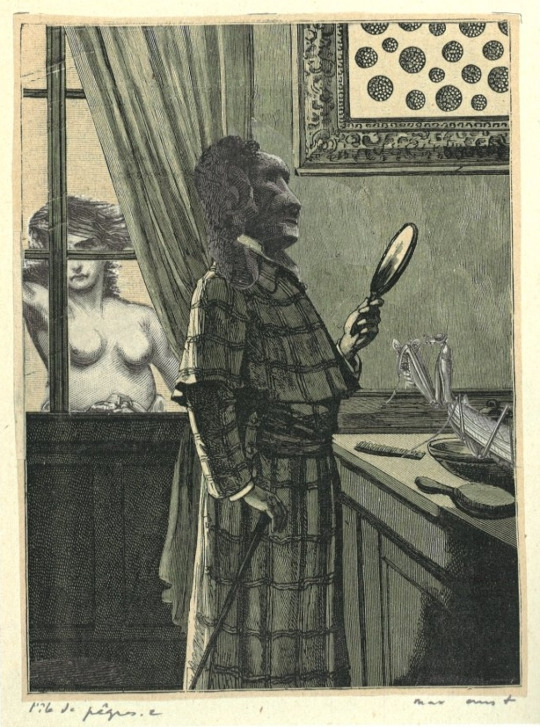
This is where we reach the last three days placed in one same booklet. It is also only in this last booklet that Ernst placed text, in the form of quotes or poems from other authors. This day has three quotes. In the "Laughter of the Rooster" segment, two. One from Marcel Shwob's L'Anarchie: "Those of them that are joyful sometimes rise their behind up to the sky and thow their feces at the face of other men ; than they lightly hit their bellies." Another from Schwob's Le Rire: "Laughter is probably fated to disappear." The third quote comes from the Easter Island segment, and is from Arp: "Stones are filled with entrails. Bravo. Bravo."
Here the symbols seem to again represent men or organizations of power. On one side, you have the recurring rooster - which is of course the symbol of France, and thus can be seen as a representation of the French government or French state. On the other side you have cruel and brutal men with the head or faces of the Easter Island statues, reflecting them not just being humans made of stone - but being literal "stones idols" (in the religious sense of the term, the sin of idolatry, again a Christian subversion).
Day 6: Friday. Element: Sight. Example: The inside of the sight / The interior of the view.
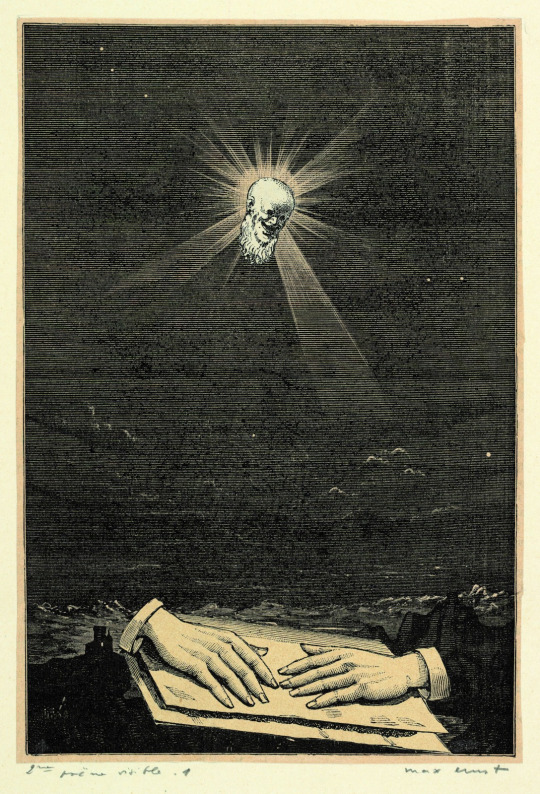
Again, three quotes here. One from Professors O. Decroly and R. Buyse's "Les tests mentaux": "If three is greater than six, make a circle around the cross, and if water extinguishes fire, draw a line from the sceal to the candle, passing above the knife, then make a cross on the ladder." One from Paul Eluard's "Comme deux gouttes d'eau": "And to love I oppose / Already-made images / Instead of images to be made" (The text is much more poetic and punny in the original French). The final quote is from André Breton's "Le revolver aux cheveux blancs": "A man and a woman absolutely white."
Unlike the previous booklets which presented dynamic, violent, active, interactive scenes, here we are in more still, contemplative images. Symbols, visions and settings to be looked at and gazed at, as the title of the section indicates.
Final day: Saturday. Element: Unknown. Example: The key of songs (again, a pun on "The key of fields", a French expression)
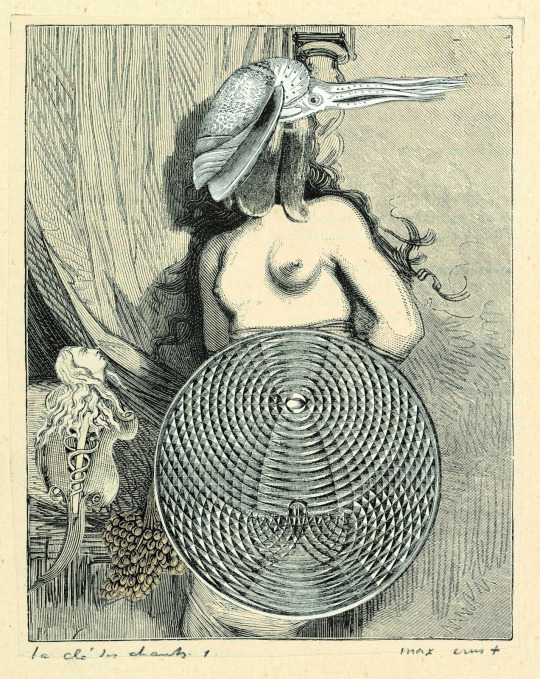
Only one quote: "........ / ........ / ........ / ......" from Pétrus Borel's "Was-ist-das".
For this part, the Musée d'Orsay used a quote by André Breton to explain Ernst's intentions: from the Surrealism Manifesto, "Glory to hysteria and its cohort of young, naked women sliding down the roofs. The problem of womankind is, to the world, everything there is of wonderful and troubled/murky." In this final day, we see women, always leaving a bed or bedroom or resting place, and either flying away or entering landscapes where gravity does not work. There is clearly here a work on the "clinal hysteria", and Ernst' own take on the surealists great obsession with hysteria, that they deemed to be disease, yes, but an illness that brought both freedom and inspiration. This idea of being set free is within the section's very title: "Prendre la clé des champs", "To take the key of the fields" is an expression meaning to go away (especially to go away from an oppressing or suffocating, unpleasant situation), to flee, escape, disappear (with the connotation of the fields as a vast, open space of great possibilities and endless horizon).
#Lovecraft#Cosmicism#Mark Z Danielewski#SCP 2747#The King in Yellow#Labyrinth#Cosmic Horror#Metafiction#Dark Fantasy#Giftedness#Maze#Gothic#Mise En Abyme#The Navidson Record#꧁ঔৣ ྀི﴿ ྀི𓊇ྀི༻ ྀི﷽ ྀི𓆸 ྀི𑣿ྀིྀ🀥 ྀི𖦹꩜𖡎¿⸮𝓒𝓘𝓡𝓒⅏𐆒𝓛⅏؏ 𝓡꩜𝓤⅏ℵ𝓓 𝓐 ⅏🝉𝓣꩜⅏ℵ⅏؏𖭅ʖ༘̇𖡎꩜𖦹🀥 ྀི𑣿ྀིྀ𓆸 ྀི#꧁ঔৣ ྀི﴿ ྀི𓊇ྀི༻ ྀི﷽ ྀི𓆸 ྀི𑣿ྀིྀ🀥 ྀི𖦹꩜𖡎¿⸮𝓣𝓗⅏؏ ⅏𐆒𝓛𝓘𝓑𝓡𝓐𝓡𝓨 ꩜𝓕 𝓐𖭅𝓡𖭅 ⅏𐆒𝓛𝓐𝓑𝓐⅏؏𝓡⅏؏𖭅ʖ༘̇𖡎꩜𖦹🀥 ྀ#Weird Fiction#Circle Round A Stone#Keyhole Book Covers#If on a winter's night a traveller#H.P. Lovecraft#Lovecraftian#Lovecraftian Horror#Recursion#House of Leaves#House of Leaves SCP#Postmodern#Postmodernism#Godel Escher Bach#HoL
20 notes
·
View notes
Text





Labyrinth (1986) dir. Jim Henson
#filmedit#movieedit#Labyrinth#by mnie#bladesrunner#userdiana#userteri#userallisyn#userrlaura#nessa007#userkd#userkam#usereena#usermandie#userjonah#tuserpris#usernewbs#userbrittany#userclara#tusertha#userangelic#tuserlyn#userrobin#useranimusvox#junkfooddaily#filmtvtoday#dailyflicks
7K notes
·
View notes
Text
to briefly revisit my decade old Labyrinth hyperfixation, I think it would be neat if Sarah grows up, has a teenage daughter who finds her book and while in a pissy mood wishes goblins would take her mother away
just imagining Sarah freaking the fuck out, taking the extremely limited amount of time she knows she has left to load up her confused daughter with all of the iron jewellery she never usually takes off, peppering her with instructions not to eat ANY of the food and vague warnings about illusions in the walls
and then suddenly before she knows it her mother is just gone, and she's being told by a strange glittery man that she must begin her own journey through the Labyrinth to find her mother
the funniest part however would be Jareth finishing his spiel to the daughter and returning to his castle to properly greet his new hostage with no fucking clue who he just snatched, and finds to his surprise and horror a Too Old For This Shit Sarah absolutely rampaging through the halls threatening to tear down his entire world all over again if he doesn't take her back to her daughter right the fuck now
I can't decide which is funnier, the tale ending with Jareth lobbing Sarah at her daughter before she even gets one foot into the Labyrinth and fucks them off home immediately, or the daughter completing her shockingly easy journey through the Labyrinth only to find her mother sitting in the king's throne with a dazed Jareth under her heel and terrified goblins waiting on her hand and foot
#labyrinth#there's probably a fic of this#there's probably tons honestly it feels like a pretty obvious plot#maybe when the MHA fixation runs out I'll dabble back into Labyrinth fic
8K notes
·
View notes
Text
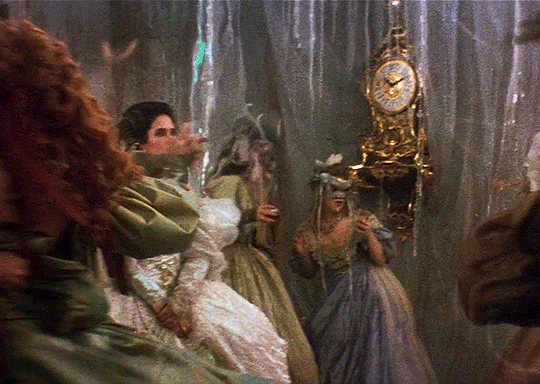
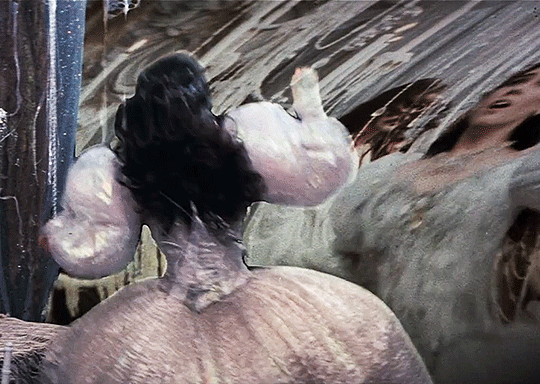

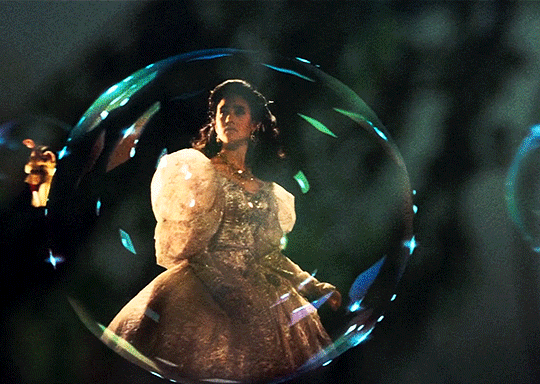
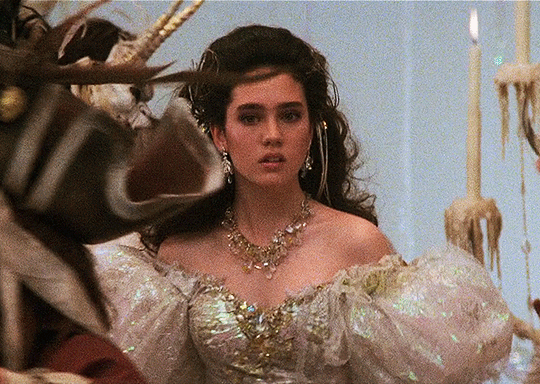
Movie Costumes | Sarah's ballgown, Labyrinth (1986)
#costumeedit#labyrinth#Jennifer Connelly#labyrinth 1986#fashion#ball gown#gown#dress#filmedit#movieedit#tvfilmgifs#filmtv#tvfilmsource#cinematv#dailytvfilmgifs#usersource#my stuff#my edits#1980s#labyrinthedit#fashionedit
16K notes
·
View notes
Text

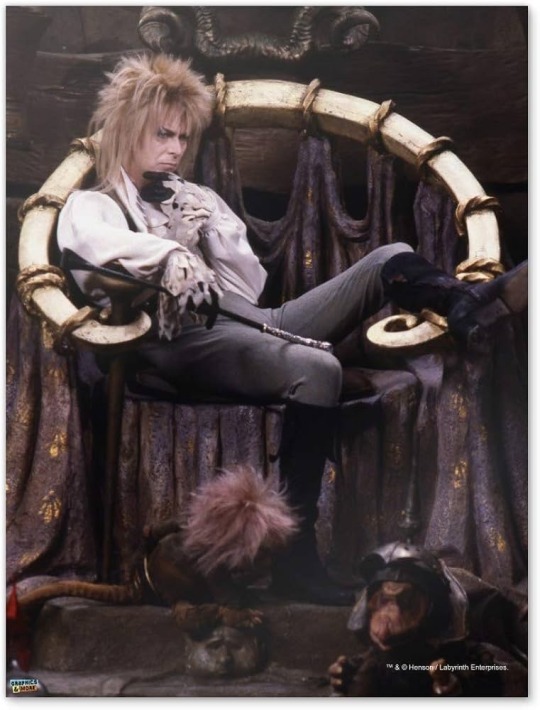
ALRIGHT... HEAR ME OUT....
2K notes
·
View notes
Text
"Just fear me, love me, do as I say, and I will be your slave."
I thought about something and now I can't un-think it

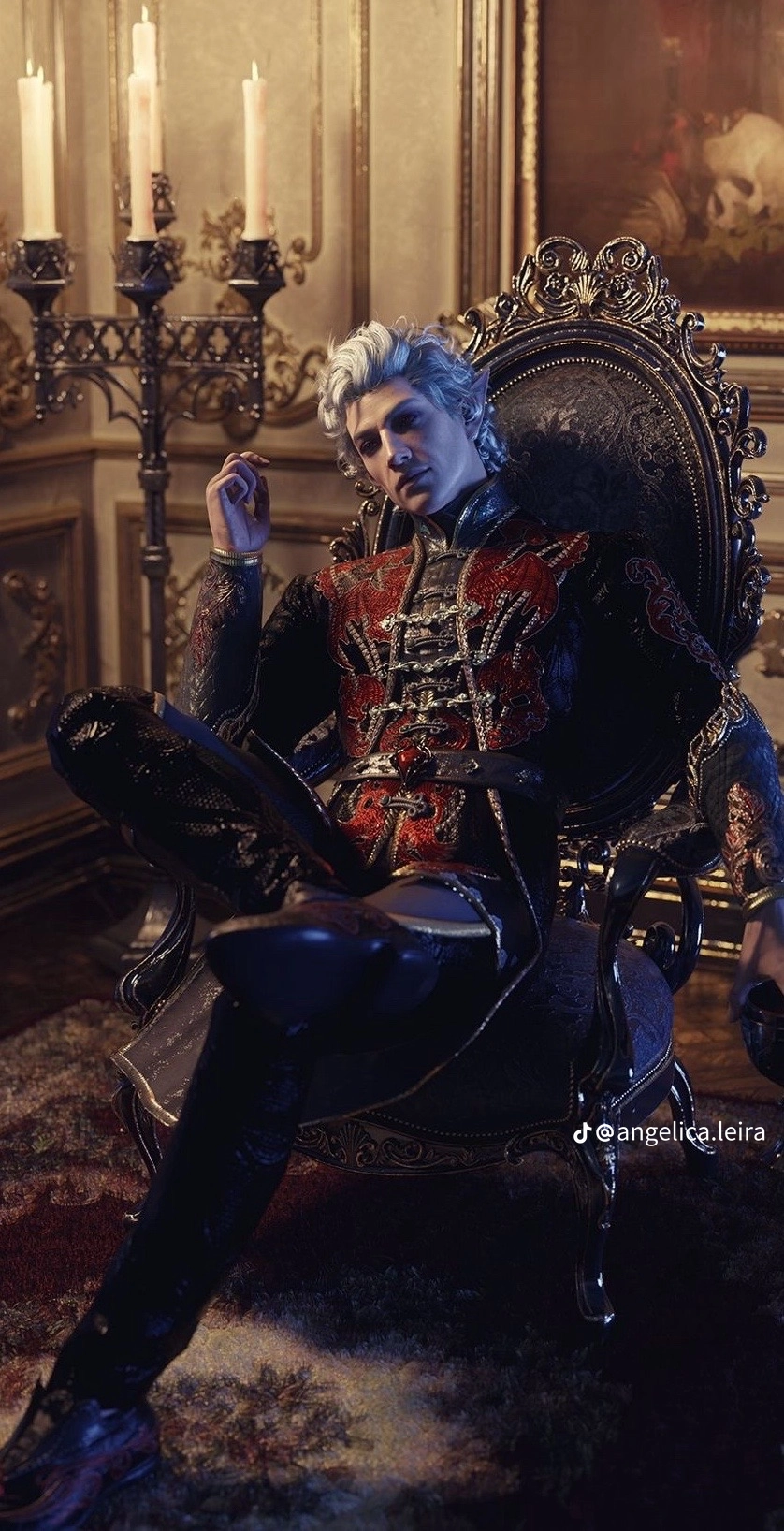
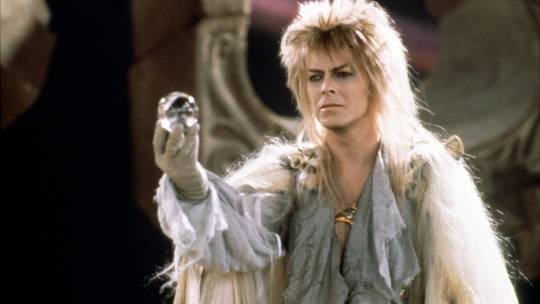


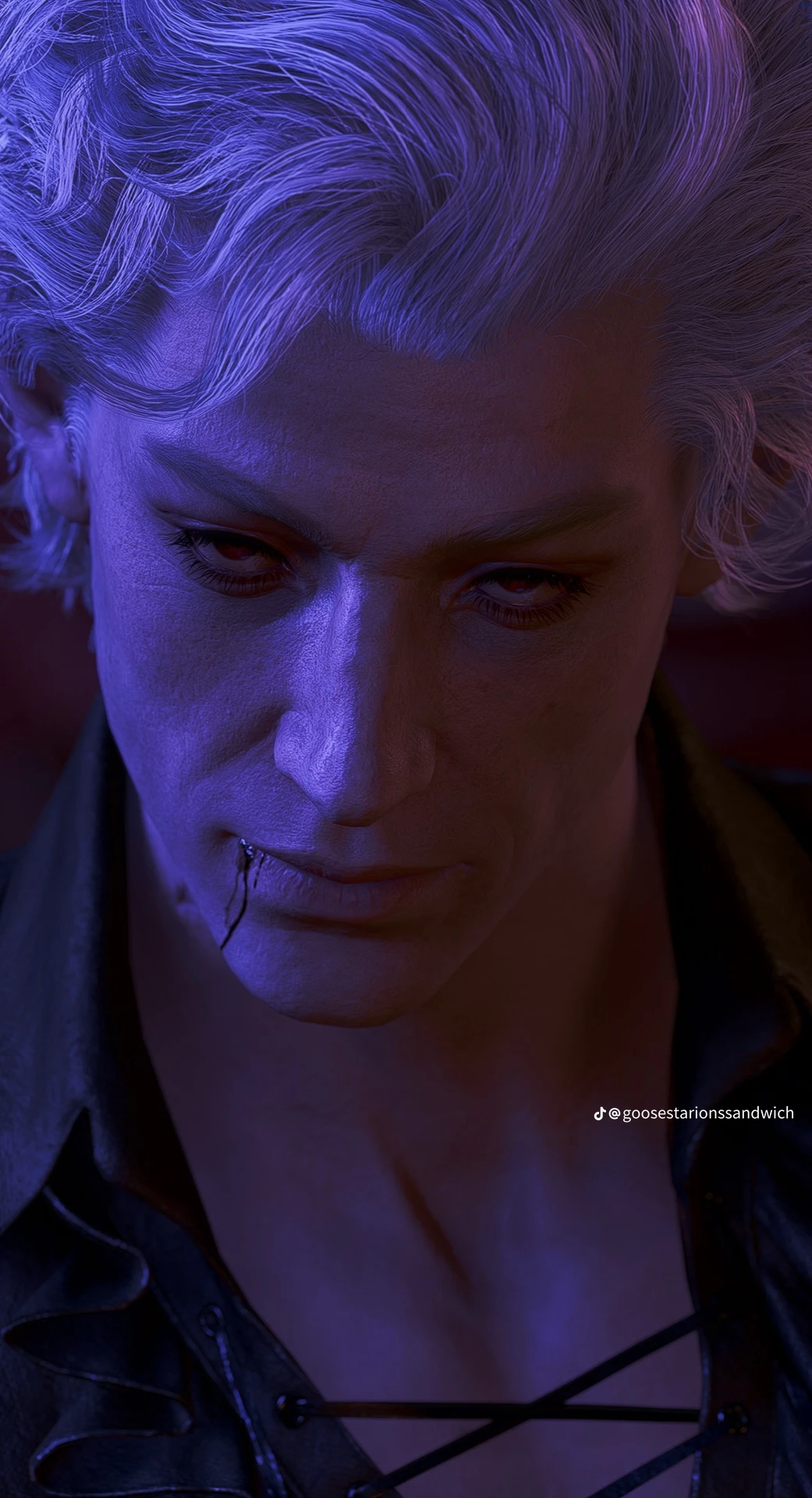
#jareth labyrinth#astarion#bg3#bg3 astarion#baldur's gate#Baldur's Gate 3#labyrinth#jareth#the goblin king#*love grip*#this is one of the best things I've ever thought about
147 notes
·
View notes
Photo
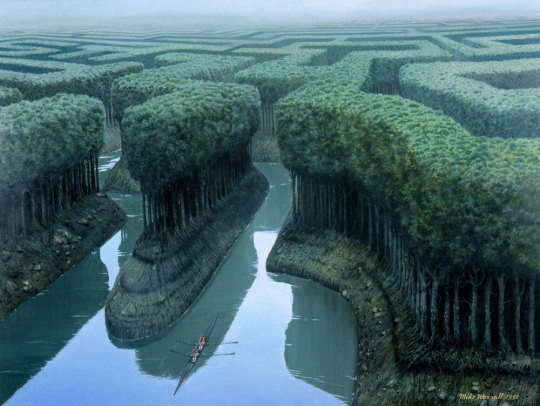
Mike Worrall, “Sculling the Forest” 1991-1996, oil on panel. B. 1942, Matlock Derbyshire, UK.
#mike worrall#sculling the forest#1991-1996#oil on panel#uk artist#oil painting#painting#art#forest#sculling#trees#canals#water#lakes#labyrinth#maze#fantasy#landscape#surrealism#magic realism#contemporary art#uk art
5K notes
·
View notes
Text























80s movie blinkies
#blinkies ⊹#blinkie#80s#movies#horror#friday the 13th#reanimator#ghostbusters#the breakfast club#blinkies#web graphics#carrd material#web resources#rentry#graphics#web decor#top gun#beetlejuice#labyrinth#the terminator#the fly#zapped#the princess bride#weird science#ferris bueller's day off#cujo#back to the future#the lost boys#tlb
3K notes
·
View notes
Text












pins by dustonmyboots
#dustonmyboots#etsy#transparent by me#pins#buttons#who wants to talk about bugs?#labyrinth#signs point to yes#who wants to talk about gay pirates?#i'm rooting for everyone trans#who wants to talk about worms?#i <3 the library#typewriter#i hate this timeline#button pins#transparent pngs#pngs#pin pngs
2K notes
·
View notes
Text
The duality (Alignment) of the word fairy

Edit; this has been updated the new Chart is pinned
Please I have learned from my mistakes
#gremlincore#fairytales#faerycore#trollcore#fairycore#faeries#flower fairy#tinkerbell#lady arwen#goblin king#labyrinth#wendy froud#maleficent#the spiderwick chronicles#pan’s labyrinth#goblincore
34K notes
·
View notes
Text

4K notes
·
View notes